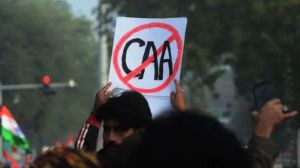Debating Vibrant Modi
Two time outs from TV soundbites,media rants and those holograms
Book: The NaMo Story A Political Story
Author: Kingshuk Nag
Publisher: Roli Books
Price: Rs 295
Pages: 188
Book: Narendra Modi The Man,The Times
Author: Nilanjan Mukhopadhyay
Publisher: Tranquebar
Price: Rs 495; Pages: 409
With so much direct speech from protagonist Narendra Modi saturating the airwaves this year,a bit of indirect speech from two journalist-authors is a relief. Of course,at first glance,the two biographies threaten to add to the tedium of the incessant propaganda which we have suffered of late in 2D and 3D and the equally smart NoMo agitprop that follows Modis outings. Sceptics could also question the timing. Even if these biographies are not hagiographies,there is no such thing as bad publicity at a time when Modi faces serious allegations in the Supreme Court from Zakia Jaffrey,widow of former MP Ehsan Jaffrey,who was killed during the 2002 riots.
But these accounts add vital details to the Modi story that usually goes missing in debates on this deeply polarising man. They provide background material,unearth new connections and help understand the Modi phenomenon,instead of pushing the reader to either embrace the PR agency APCOs spin or the NoMo counter-slogans.
Kingshuk Nag and Nilanjan Mukhopadhyay have stepped back a bit and written biographies that are exactly that,careful to recognise what makes Modi who he is in India today,but equally careful to look at all the stages of his life and add to the knowledge bank about the man. The Gujarat riots are assessed in detail and Modis role in abetting or choosing not to prevent them is clearly brought out. Both writers have known Modi and closely followed the context that spawned him. They are able to chart the inside track on Narendrabhai Modi which is usually lost in the NaMo vs NoMo fight. This includes vital details from within the parivar,of the fissures within the Hindutva Divided Family. Both accounts unravel,without rancour,the darling of industry and the Gujarat Hriday Samrat,and also the risk-averse master organiser obsessed with publicity and image,who has been keen to finish off competition but first,within his own side.
Kingshuk Nags book is just 184-pages-long and extremely readable. It stays on course and yet has details that are not well-known. It situates Modi in the times and the times in Modi,starting with the late 1980s in Gujarat and onwards,through the rise of the Sangh Parivar and the BJPs,the shock of the loss of two key players,Pramod Mahajan and Govindacharya,and the vacuum in the second rung left behind by organisers who had been recognisable faces. The book starts with a big bang introduction and captures Modi in the context of the new economics,new aspirations and caste politics of the 1990s. It tracks the rivals whom Modi worked hard to sideline,and reveals how,sent back to Gujarat,he turned it into an opportunity to unleash a pushy and unabashed I,Me,Mine political project. Modis hard climb to the top,specially his earlier years helping his father at his teashop in Vadnagar,the adversity of being a member of the ghanchi (oil-presser) caste in a milieu that recognised merit only in the upper castes,are instructive.
This book offers clarity in examining complex issues as it evaluates Modis journey from the riots to Vibrant Gujarat,powered by statistics which were often whitewashed,shouted with aplomb to render them believable. In a society obsessed with NRI-ness,we see Modis attempts to break US and EU visa barriers through skilled economics. The author suggests that the high commissioner of the UK in India was persuaded to call on him in what may have been part of complex Gujarat Gas economics. Modis identification with Japan and China was plotted as a way to break the problems he was having with the West. But the author is quick to point out how the tensions between classic Sangh-ism and Modi keep surfacing,and even the embrace of China had led to frowns in Nagpur,as belligerency towards this neighbour is a vital card in the Sanghs armoury.
Nilanjan Mukhopadhyays book is more than twice the size of Nags and is heavy on the times before Modi became chief minister. This books USP burdens it at times. Mukhopadhyay,a fine essayist of the Babri Masjid phase in Indian politics,is surprised when Modi agrees to assist him with a long interview,but later withdraws his pleasure. So while nuggets emerge,such as Modis own definition of Hindutva (a very unclear idea but nevertheless,its his definition,on the record) the burden of having spoken with Modi is palpable. But Mukhopadhyays excellent interviews with others within the Sangh fold talk of the problems the proponents of Hindutva feel Modi has lumped them with,rendering it a synonym for violent and exclusionary politics,the anti-thesis of the image they want to create.
This books strength is the chapter Development Sutra,where the author concludes that Sonia Gandhis famous maut ke saudagar (merchant of death) comment is probably true for the saudagar bit; as Modi has the capacity to peddle maut or vikas,depending on what is appropriate for the moment.
Both books deal with the Haren Pandya moment competently,recounting how Modi was unwilling to allow him to contest,and how he checked into a hospital to make a point to the central leadership. Pandya,of course,was shot dead mysteriously shortly after,while on his morning walk. They deal equally interestingly with Modis relationship with LK Advani and other mentors,his excellent memory and his family. The cloud of mystery around his estranged wife Jashodhaben is dealt with empathetically. The Modi kurta and other sartorial and style obsessions of the Gujarat CM are given due weightage and make interesting reading. In short,these books take the reader from the level of NaMo and NoMo to KnowMore.
Quick Reads
The Namo Story Read the introduction,Winds of Change and Vibrant Gujarat.
Narendra Modi,Read The Development Sutra and The Enemy Within to hear Modi speak about himself.



- 01
- 02
- 03
- 04
- 05




























